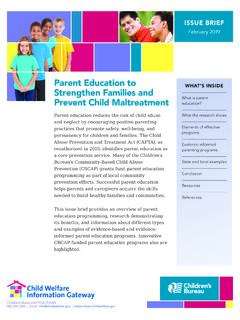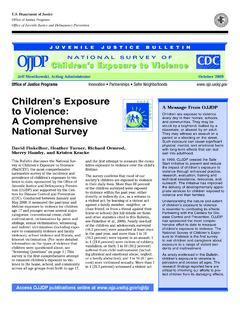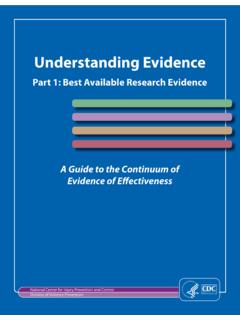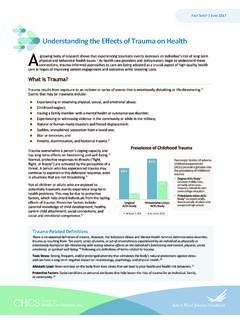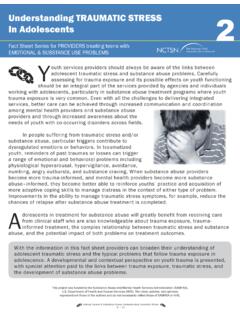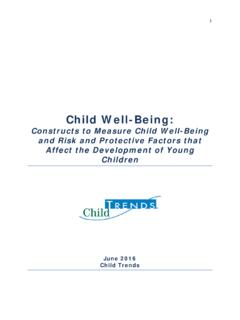Transcription of Intergenerational Patterns of Child Maltreatment: What …
1 Children s Bureau/ACYF/ | Email: | BRIEFA ugust 2016 Intergenerational Patterns of Child maltreatment : What the Evidence ShowsWHAT S INSIDET heories to explain IGMWhat the research showsPractical implicationsAreas for further researchConclusionAppendix A: Research findingsAppendix B: Reading the researchReferencesThe majority of children who experience maltreatment do not become adults who abuse or neglect their own children. Our review of nearly 3 decades of research on the topic reveals that Intergenerational Patterns of Child abuse and neglect are far more complex and nuanced than originally understood. Although this research is limited, it is important for practitioners, administrators, and others who work with children, youth, and families to have an accurate understanding of the issue. Incorrect conclusions about the existence, extent, and causes of Intergenerational maltreatment (IGM) could lead to ineffective screening tools, harmful social policies, worker bias, and poor outcomes for children and time, a stronger research base will continue to increase our understanding of the factors that contribute to Patterns of maltreatment within families.
2 This will enable Child welfare, family support, and other organizations to more effectively promote protective factors and address risk factors in ways that can benefit all issue brief explores what is currently known about Intergenerational Patterns of maltreatment , the limits of our current knowledge, implications of what we know and what we do not know (including promising prevention strategies), and areas for further Patterns of Child maltreatment : What the Evidence Shows2 material may be freely reproduced and distributed. However, when doing so, please credit Child Welfare Information Gateway. This publication is available online at to Explain IGMS everal theories have been cited to improve our understanding of Intergenerational Patterns of maltreatment (Thornberry & Henry, 2013). The most prevalent include the following: Social learning theory proposes that individuals behavior is shaped through observation and imitation.
3 Therefore, this theory suggests that adults parenting will be influenced by childhood experiences of their own parents behaviors. If individuals experience abusive or neglectful parenting, then they may develop beliefs that these behaviors are acceptable and/or effective and replicate them with their own children. Attachment theory emphasizes the importance of a quality, early attachment with a caregiver. If a caregiver is not caring and sensitive to an infant s needs (as is the case when early maltreatment occurs), the affected individual struggles to form healthy attachments into adulthood. This is theorized to increase the likelihood of abusive behavior as an adult. Trauma-based models suggest that maltreatment , like other forms of violence, produces trauma symptoms. If untreated and unresolved, these symptoms may increase the likelihood that the individual will engage in violent behavior, including Child maltreatment , as an adult.
4 Ecological or transactional theories view Child maltreatment as the result of multiple influences and systems, including family, community, and societal factors. Research grounded in these theories looks for specific risk factors or pathways to better explain Intergenerational the Research ShowsAlthough many researchers have attempted to quantify and explain the persistence of Child abuse and neglect across generations (see appendix A for a partial list), many in the field agree that the current evidence base is still woefully inadequate. This is due in part to the fact that sample sizes, measurement tools, and even the ways that key terms are defined vary greatly from study to appendix A shows, sample sizes range from fewer than 100 participants to many thousands. Data about maltreatment experienced by parents (G2) and children (G3) are collected in a variety of ways, including retrospective self-reports by parents and/or children (sometimes, but not always, using validated survey instruments, such as the Child Trauma Questionnaire), observations of parenting behavior, and official reports made to Child protective services (CPS) agencies.
5 Some studies base their findings on either risk or potential for abuse, via the Child Abuse Potential Inventory (CAPI), rather than actual agreement exists about how Child maltreatment is defined across studies. Some studies rely on participants own perceptions of childhood experiences as abusive or neglectful, while others establish specific parameters about maltreatment type, perpetrator, and severity. Some studies assess maltreatment of the G3 Child for as short a period as the first year of life, while other, longitudinal studies include incidents of maltreatment occurring at any time before the Child turns 18. Finally, studies differ in how rigorously they control for other factors that may impact the incidence of IGM ( , parental age, race, marital status, gender, socioeconomic status, community factors).Given this diversity in approaches, it is not surprising that some studies find associations between parents and children s experiences of maltreatment , while others do not ( , Altemeier, O Connor, Sherrod, Tucker, & Vietze, 1986; Renner & Slack, 2006).
6 In the majority of studies that find evidence of IGM, estimated rates of maltreatment vary widely and range between 7 percent and 70 percent (Berzenski, Yates, & Egeland, 2014).For additional information about how to assess the strength and applicability of individual studies, refer to appendix Research Findings Not all parents who experienced childhood maltreatment will perpetrate Child abuse or neglect. In fact, nearly all studies on the subject agree that most parents who experienced maltreatment will not abuse or neglect their own children. Many (but not all) studies on the topic have found that parents who experienced childhood maltreatment are, as a group, more likely than non-abused parents to have children who are abused or neglected. It is not yet clear why this is true or what factors make the greatest difference for families. Findings vary greatly depending on how the study is constructed and the types of maltreatment studied.
7 Even when Intergenerational Patterns are found, the adults who experienced maltreatment in one generation are not necessarily perpetrators in the next. In other words, the children of parents who experienced childhood maltreatment may be at increased risk of being maltreated either by that parent or by another Why: Findings About PathwaysSome research looks specifically for factors that explain or account for the apparent association between a parent s experience of childhood maltreatment and the maltreatment experienced by his or her own children. These factors (referred to as mediators in the research) can be thought of as pathways for IGM. Identifying these pathways can help practitioners develop and select the most effective prevention is much more research needed in this area, but some of the stronger studies identified the following factors that may partially account for Intergenerational Patterns .
8 Mothers social isolation and tendency to respond to minor provocations with verbal or physical aggression (Berlin, Appleyard, & Dodge, 2011) Maternal substance use (Appleyard, Berlin, Rosanbalm, & Dodge, 2011) Young parental age, parents history of mental illness or depression, and parents living with another violent adult (Dixon, Browne, & Hamilton-Giachritsis, 2005) Parental age, educational achievement, psychiatric history, and poverty (Sidebotham, Heron, & ALSPAC Study Team, 2006) Mothers marital status, depressive symptoms, and adult experiences of victimization (Thompson, 2006) Mothers life stress, anxiety, and depression (Egeland, Jacobvitz, & Sroufe, 1988) Parents experience of intimate partner violence (Renner & Slack, 2006)It should be noted that many of these risk factors are found in a wide variety of families, not just those in which parents experienced childhood maltreatment .
9 Future research may reveal that these factors play a far more significant role in a Child s overall risk for maltreatment than parental Patterns of Child maltreatment : What the Evidence Shows3 This material may be freely reproduced and distributed. However, when doing so, please credit Child Welfare Information publication is available online at Effectively: Findings on Protective FactorsIdentifying protective factors is integral to prevention efforts. This requires studies that look closely at the high percentage of families in which there is Intergenerational resilience ( , cases in which adults who experienced childhood maltreatment do not abuse or neglect their own children) to understand what factors help promote healthier interactions within families. Caring and supportive relationships, in various forms, have emerged in the literature as a potential protective factor: Several studies published in a special issue of the Journal of Adolescent Health examined the role of safe, stable, and nurturing relationships (SSNRs) in interrupting the Intergenerational transmission of parenting practices, including Child maltreatment .
10 All but one of the studies found positive effects of SSNRs, including caregivers nurturing romantic relationships and caring parent- Child attachments in both generations (Conger, Schofield, Neppl, & Merrick, 2013; Herrenkohl, Klika, Brown, Herrenkohl, & Leeb, 2013; Jaffee et al., 2013; Thornberry et al., 2013). One study found that mothers who broke the cycle of severe physical abuse were more likely to receive emotional support from a nonabusive adult during childhood, participate in therapy11 A later study by Egeland and Susman-Stillman (1996) found that mothers who perpetuated a cycle of maltreatment were more likely to engage in idealization, inconsistency, and escapism when describing childhood experiences. Mothers who broke the cycle displayed a greater ability to integrate their abusive experiences into a more coherent view of self, a process that may be aided by professional therapy.












